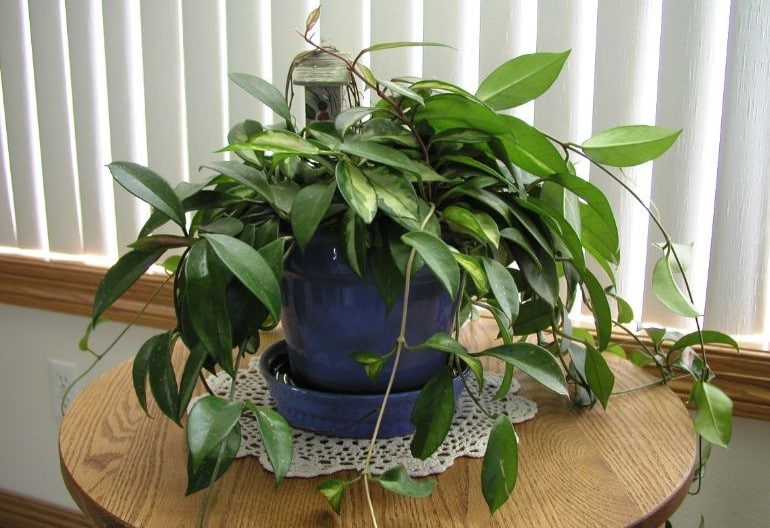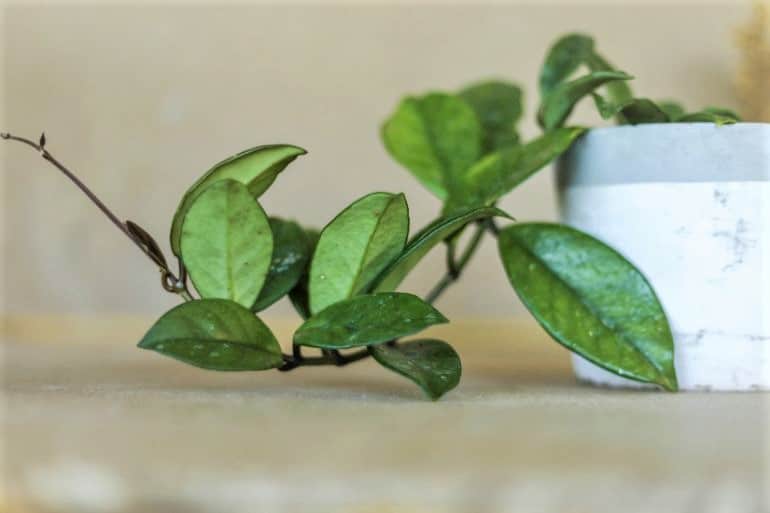One of the joys of keeping plants is watching them grow, so it’s jarring to have a Hoya that sits in its pot refusing to budge. This common issue has many potential causes – or even a combination of reasons. Let’s look at why your Hoya is not growing and how to help it thrive again.
The most common cause of a Hoya not growing is insufficient light. Most Hoyas prefer bright, indirect light to grow strongly. Root damage caused by poor drainage or overwatering, or stressors such as pests, low humidity, acclimation, and fertilization issues can also stop a Hoya from growing.
Overview: Why Is My Hoya Not Growing?
Hoyas make phenomenal houseplants but are … unintuitive. Quirky, even. Even knowing this, it’s frustrating when your neighbor’s Hoya is practically leaping out of its pot while yours imitates a still life painting.
The first thing to do is research your species. Some Hoyas like high temperatures and humidity; others prefer cooler conditions and don’t mind drier air. Species with thin leaves consume a lot of water while thick-leaved varieties like to (briefly) dry out.
One relevant question is: How fast does your specimen naturally grow? If your Hoya isn’t a sluggish variety, the reason it isn’t growing is almost certainly related to its environment and care.
Manage Your Expectations
The Hoya family is a unique – okay, strange – group that generally grow more slowly than many houseplants.
They do things their own way, too. Hoyas are known for taking mysterious breaks and then breaking into an onrush of new foliage. Many produce a bare tendril and slowly fill it with leaves … when they get around to it.
To compound the issue, Hoyas quickly grind to a halt if conditions go wrong and take their sweet time starting up again.
The Heartbreaking Hoya Kerrii
One common disappointment is the adorable but motionless Hoya kerrii. Its green, heart-shaped leaves are sold as cuttings perched upright in little pots; they are popular Valentine’s Day gifts.
Hopeful owners wait for new growth that never seems to come. The cute plant remains healthy-looking and evergreen, and even grows a small root system. The trouble is that its leaves only grow readily if a piece of stem is attached to the cutting.
It isn’t a scam, though: give your little Kerrii good light, warmth, and a tiny pot, and it should eventually produce new growth. But it might literally take years to grow from a leaf.

Reasons Why Your Hoya Isn’t Growing
Let’s take a look at some of the common problems that can cause your Hoya to stop growing. I’ll help you identify each problem, and provide tips to get your plant thriving again.
Seasonal Growth
Hoyas naturally go semi-dormant during the cooler winter months. Even if kept indoors, they can sense the change of seasons due to changes in light coming through the window.
You may not realize your Hoya has gone dormant. They don’t shed leaves or make outwardly dramatic signs … they simply pause their growth until the new season.
Acclimation Time
If you’re used to plants that bounce back quickly after a relocation or repotting, Hoyas will take some getting used to. They tend to sulk if their conditions change.
This can be discouraging if you’re eager to see your new Hoya get going, but don’t panic – if the plant looks healthy, it is probably only adjusting.
There isn’t a lot you can do to speed the process, but there are definitely some mistakes to avoid. Here are some no-nos:
- Don’t move the plant from place to place – establish a suitable permanent location and leave it there.
- Don’t increase watering beyond what is sufficient; the only thing that will encourage is root rot.
- Don’t try to stimulate it with fertilizer. A Hoya that’s not growing will not be happier sitting in more chemicals.
Improper Lighting
Some retailers label Hoyas as low-light plants, but that isn’t the full story. Their natural habitat provides bright light filtered from intense, direct sun. Their growth is usually inhibited by dim conditions.
Species vary, of course: some can handle less light, and a few can take full sunlight. They all thrive in bright, indirect light, however, and most will need protection from the sun if kept outdoors. Too much sunlight can retard growth, too.
Pro Tip: If your slow-growing Hoya is already getting moderate light, wash or gently wipe the foliage to remove dust that can block illumination.
Hoyas do quite well in artificial light – since these sources can be controlled, they are an excellent way to optimize your plant’s light. Between 12 and 14 hours should be enough for good growth. Ensure a period of darkness each 24-hour cycle.
Is Your Hoya Not Growing Due To Poor Drainage?
Overly wet soil will not only stop growth, it can kill your Hoya by fostering root rot. Healthy roots are crucial. Watering too often is the most common cause, but the soil and even your plant’s container are key factors.
Your Hoya’s pot should have drainage holes to let the water escape. If you want to use a decorative container that doesn’t have exit holes, put your plant in a pot with proper drainage and place it inside.
Well-draining soil is critical to your Hoya’s success. Even after a thorough dousing, you don’t want the medium to hold too much water.
Hoyas aren’t particular about the exact ingredients of their soil as long as it drains well.
Here are a few ways to achieve the proper mix:
- Combine two parts potting soil with one part each of perlite and orchid bark.
- Use cactus or succulent potting soil with additional aerating amendments like pumice, perlite, or coarse sand.
- Mix coconut coir with an equal quantity of aerating elements.
- Add half-and-half sphagnum peat moss with aerating materials.
Note: Consider adding dolomite lime or other calcium source to neutralize the acidic effect of peat moss.

Watering Issues
Either too much or too little soil moisture can prevent your Hoya from producing healthy growth.
As epiphytes, Hoyas typically like their soil to be moist, but their small root systems easily succumb to root rot. Their little roots dry out easily, too; walking this line takes some experience.
In general, letting the top one or two inches of soil dry out before rewatering works well, and letting the soil dry between waterings helps keep trouble at bay. Different Hoya varieties have their own preferences, however, so research your species for a specific recommendation. See these tips for watering houseplants to learn more.
It’s best to give Hoyas a small pot that won’t leave them floundering in a lot of water-holding soil. Empty any cachepots after watering so the container never sits in a puddle.
Humidity Problems Impacting Hoya Growth
Hoyas generally love humidity. It helps them grow and promotes stronger roots.
If your Hoya isn’t producing and you’ve ruled out other issues, raising humidity may get things moving. Even species that tolerate low humidity often show their appreciation for higher levels with increased growth.
One caveat to high humidity is that it provides ideal conditions for fungal infections. You can minimize that drawback by ensuring the plant has good airflow. As treetop dwellers, they like to breathe.
An Oversized Container Can Stop Your Hoya From Growing
After being repotted or transplanted, Hoyas tend to concentrate on establishing their roots before producing new foliage.
This means your Hoya which looks healthy but seems inactive may be growing quite nicely below the surface. Allowing them extra soil often slows upper growth: the plant remains frozen above ground while its root system explores the expanse of mix below.
There’s an easy fix, though: a snug pot! The Hoya’s diminutive roots don’t mind being slightly rootbound. Tight quarters often stimulate both leaf production and blooming.
An oversized pot also greatly increass the risk of overwatering, as it will take a long time for the soil in a large pot to dry out. If you notice the soil takes weeks to dry out after watering, repotting into a smaller pot is one way you can help prevent problems.
Cold Or Fluctuating Temperatures
Hoyas are warm-weather plants. Even those that like mild daytime temperatures will stop growing if conditions drop below their preferred range.
Production slows as temperatures fall under 60Fº (16ºC) – the plant begins to suffer actual damage below 50°F (10°C). Drafts are also important to avoid.
If your Hoya endures a cold snap or sits in cool temperatures too long, it may well bag the whole season and go semi-dormant. In that case, don’t expect further growth until the plant recovers.
Is Your Hoya Not Growing Due To Fertilization Issues?
Hoyas are not heavy feeders, so most fertilization problems are about overfeeding. Applying too much fertilizer can backfire by toxifying the soil, which prevents uptake by the roots and derails growth.
Here are some rules for fertilizing a Hoya:
- Most species thrive with dilute applications every six weeks during the growing season.
- Use only 1/4th of the label’s recommendation.
- Stop fertilizing during the cool months or any time the plant is dormant.
- Don’t continue to feed a plant that isn’t growing, no matter which season it is.
To help prevent residue buildup, it’s a good practice to flush the soil at watering time. Run extra water through the mix and let it drain thoroughly. If you suspect overfertilization, flush the soil several times during your next watering.
If fed properly, Hoyas can thrive on either organic or synthetic fertilizer. However, organics have a greater safety range against overfeeding and provide extra micronutrients, too.
Last Word
The best way to work out why your Hoya isn’t growing is by looking at each of the potential causes one by one and making changes to improve the growing conditions for your plant. I always find it so rewarding to slowly restore a plant to health, and I really think that dealing with a struggling plant is one of the best ways to learn how to grow healthy houseplants.
This website is full of information about how to care for houseplants, and how to fix common issues when they arise. Take a look at some of my other articles listed below, or check out my book “Houseplants Made Easy“, which covers everything you need to know to grow healthy houseplants.

